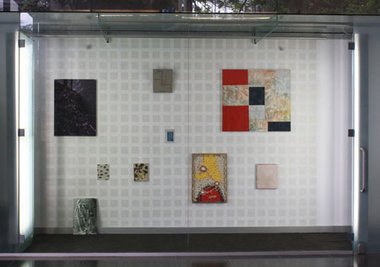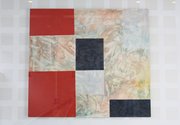John Hurrell – 5 February, 2011
For people who want to think about the materiality of unconventionally painted wall objects and the application (or removal) of sticky coloured substances on occasionally unstable surfaces.
Auckland
Anoushka Akel. Richard Bryant, John Drawbridge, Johl Dwyer, Selina Foote, Patrick Lundberg, Judy Millar, Sam Rountree Williams, Rohan Wealleans
Paintings Paintings
Curated by Selena Foote
26 January 2011 - 25 February 2011
Readers of the last post pondering Creon’s discussion of the bar-codes for iphones (that Andre Hemer has as possible painterly ingredients) might wonder what is painting’s technology today, and how can its use be focussed within a painting practice in order to be conceptually meaningful? How can somebody like Hemer incorporate online imagery that he has curated so that it (viewed on an iphone) synthesises formally, associatively and/or ideationally with coloured marks and shapes on a wall or canvas? If he succeeds in creating something more than a mere pointer to information he is indisputably important, for he is taking painting to a new hitherto unexplored dimension.
But this Window show I’m looking at here is quite different in its themes. It examines at non-electronic technology (chemical as it were), but like the sites linked to Hemer’s bar-codes, it with nine separate paintings makes up collectively a tenth work - a large painting, behind and on the glassy window.
The nine works, pulled out of their own individual working practitioner contexts, here are positioned by Selina Foote with great intelligence. The background wall is painted with a regular grid of small grey squares bordered by rows and columns of white lines. Attached to the centre of the pane of glass at the front is a photograph of a John Drawbridge painting.
Foote‘s interest in these works revolves around the issue of ‘what to paint and how to paint it’ and is prefaced by a 1944 quote from Barnett Newman declaring his preoccupation with ‘the technical problems of the painting medium.’ At this time new research was being developed by paint companies exploring non oil-based media, and sample cans of polymers and acrylics were being given to abstract artists to try out. Some of them, like Morris Louis, later died because of the carcinogenic side effects. Medical investigation of the consequences of their chemical properties was tragically unheard of.
These contemporary (and presumably much safer) works are laid out so that within the one ‘painting’ the nine elements converse with each other. There are no wall flowers at this party; everybody is included -mainly in pairs or triples.
At the centre at the top is a small bluish gray Patrick Lundberg painting of thin masking-tape masked lines that emphasise right-angled intersections with vertical and horizontal vectors. These corners accentuate the rectangles all these artists use, while a large Sam Rountree Williams on the right has some hard edged red and black squares floating in front of some agitated and softly smudged finger painting.
Rountree-Williams’ palette acts as a foil for similar reds and blacks found in Rohan Wealleans’ carved-out-of-stratified-acrylic work while below it the Anoushka Akel scrubbed pinky-yellow painting references the righthand side of Rountree Williams’ contribution. Foote’s nearby small composition of triangular facets links to Wealleans crystalline mini-mountain ranges.
On the lefthand side of the gridded wall, Richard Bryant’s intimate watercolour has rhythmically placed dark smudges that play off against Foote’s crisp black acrylic triangles, while on the upper lefthand corner a black field of paint from Judy Millar (scraped off a pink undercoat) leaves more splitting, angular, crystalline tensions.
Leaning against the wall below, Johl Dwyer has an oblong of thick white paint encrusted over wire or sticks that have been covered with brown and orange. This plasterlike coating has been sprayed from one side with a finely drizzled black to create a lopsided spatial tension that undermines the coarse and lumpy materiality of the object and which has also slid off. Oddly, with its raw vertical tensions, the piece seems like a distant cousin to the diagonally composed Millar.
The last work, the photographed Drawbridge, seems in comparison flat and insubstantial under the glass, and a link to the mottled textures of Rountree Williams, Wealleans and Akel. A witty accentuation of the vertical traylike properties of the venue is achieved by the photo’s location, hovering by itself on the glass frontage. However it is difficult to consider many of these paintings as satisfying, self-contained ‘inner worlds’ in isolation. Here in this show’s context they are more interacting elements locked in a field.
I’ve tried to elucidate some of the intriguing points of comparison going on but without accompanying photos this review remains, I know, exasperatingly vague. Yet whatever the limitations of my descriptive writing, this is a successful Window show for people who want to think about the materiality of unconventionally painted wall objects and the application (or removal) of sticky coloured substances on occasionally unstable surfaces. As a group, these paintings are an exceptionally resonant combination.
John Hurrell










 Two Rooms presents a program of residencies and projects
Two Rooms presents a program of residencies and projects Advertising in this column
Advertising in this column



This Discussion has 0 comments.
Comment
Participate
Register to Participate.
Sign in
Sign in to an existing account.